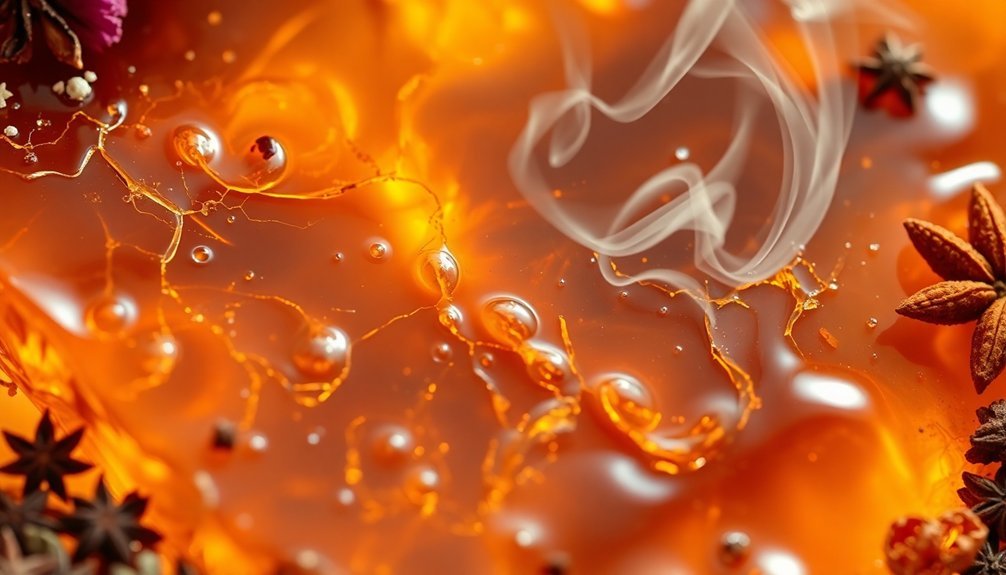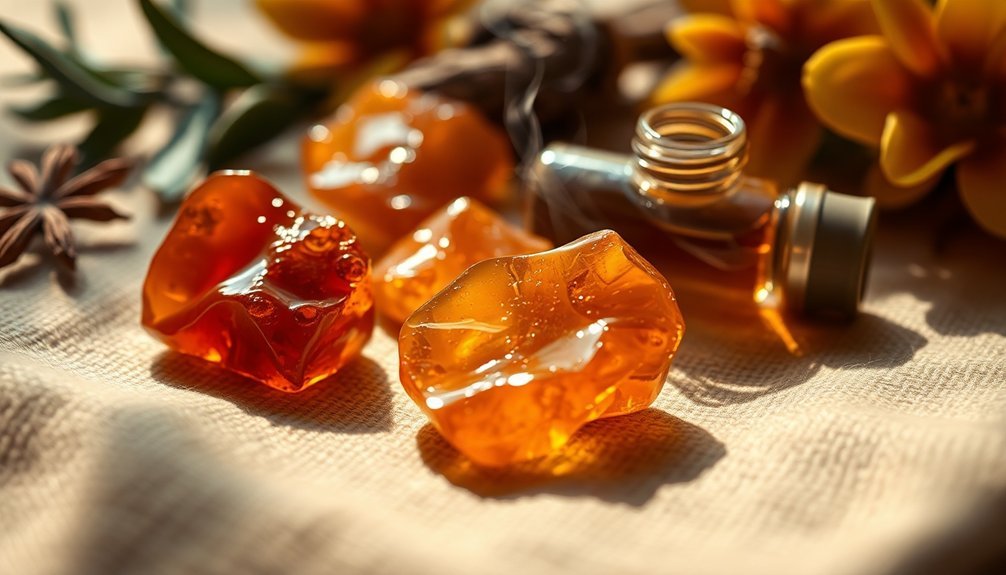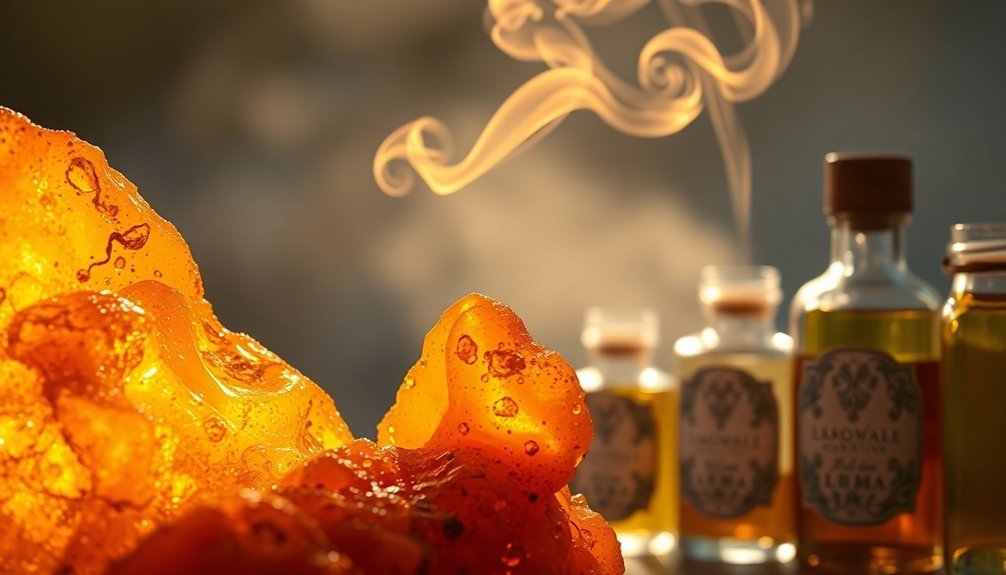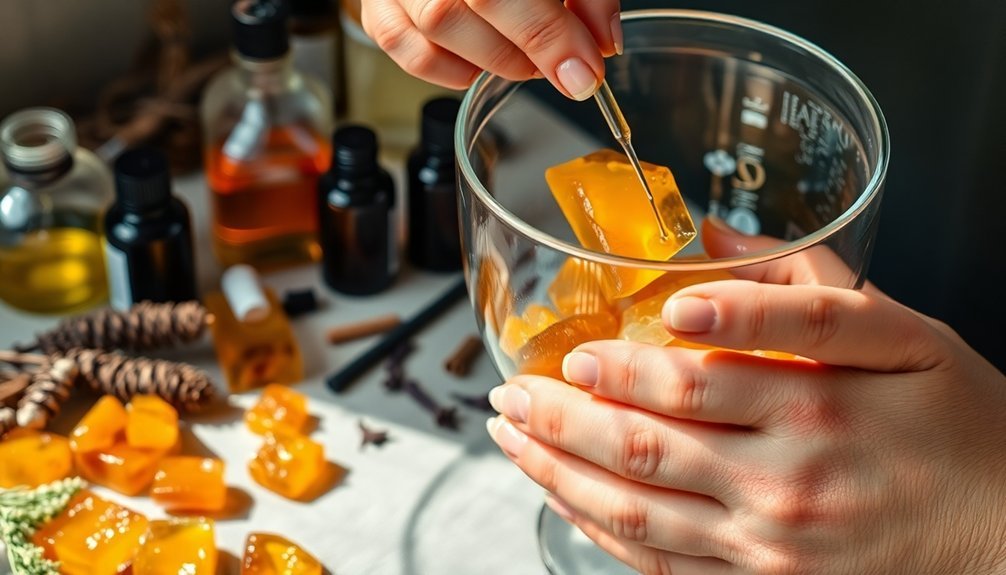DIY Oriental amber lets you craft a truly personal fragrance that evolves uniquely on your skin throughout the day. You'll blend warm vanilla, earthy labdanum, and spicy benzoin with subtle musks to create a sophisticated, lasting aura. By customizing the ratios of natural and synthetic ingredients, you're able to develop a signature scent that captures both tradition and modern allure. The art of oriental amber creation holds many more enchanting secrets waiting to be discovered.
The Mystery Behind Oriental Amber's Enchanting Appeal

While many fragrances come and go, Oriental amber's allure has captivated perfume enthusiasts for centuries.
You'll discover its magic lies in the complex harmony of resinous elements, sweet undertones, and spicy accords that create an immersive sensory experience. When you wear Oriental amber, you're embracing a fragrance that evolves uniquely on your skin, revealing layers of warm vanilla, earthy labdanum, and spicy benzoin. The experience leaves behind a sophisticated lasting aura that persists throughout the day.
What makes this scent truly exceptional is its ability to forge an emotional connection. You're not just wearing a perfume; you're wrapping yourself in centuries of cultural significance and mystique.
The velvety richness of amber, combined with its smoky undertones and golden warmth, creates an aura of sophistication that's both primal and refined. It's this perfect balance that makes Oriental amber timelessly enchanting.
Essential Components for Your DIY Amber Blend
Creating your own Oriental amber blend starts with understanding its core building blocks.
You'll need vanilla or vanillin as your foundation, which adds essential sweetness and powdery notes while balancing other ingredients. Resins are your next vital element – particularly labdanum, benzoin, and myrrh – bringing warm, smoky, and earthy qualities to your creation.
Don't forget to incorporate musks, whether synthetic options like Galaxolide or natural alternatives, as they'll provide the soft undertones that complete your amber accord. The soft, oriental material characteristic of amber makes it perfect for creating memorable fragrances.
For a unique signature, you can experiment with accent notes such as tonka bean, Peru balsam, or patchouli. These additions let you craft either sweet or dry variations of your amber blend, while iris can introduce subtle powderiness to contrast with labdanum's warm, balsamic character.
Crafting Your Signature Oriental Base Notes

When crafting your oriental base notes, you'll want to start with carefully selected raw materials like amber, vanilla, or precious woods as your foundation.
Begin layering these potent ingredients gradually, ensuring each note complements the others while maintaining the characteristic depth of oriental fragrances.
You can achieve the perfect balance by combining sweet elements like vanilla with deeper notes such as patchouli or sandalwood, adjusting the ratios until you've created your desired signature scent. These carefully orchestrated elements will provide your fragrance with remarkable tenacity and hold, typical of oriental perfume families.
Layering Essential Base Notes
To master oriental perfumery, you'll need to understand how base notes serve as the foundation of your fragrance. These dense, intense notes evaporate slowly, giving your perfume its lasting character and soul.
When crafting oriental base notes, you'll want to focus on key ingredients like vanilla, amber, and exotic resins. Start with warm spices such as cinnamon, clove, and cardamom, then layer in smoky incense notes like frankincense or myrrh.
Add grounding elements of sandalwood or cedar to create depth. You'll find success by carefully balancing sweet and spicy elements.
Consider incorporating ambroxan or vetiver to offset sweetness and add masculine undertones. If needed, you can adjust the overall composition with small amounts of bright top notes like petitgrain or grapefruit to achieve the perfect harmony.
Raw Materials Matter Most
The quality of your raw materials directly shapes the success of your oriental amber creation.
You'll want to invest in premium ingredients that form the foundation of your signature scent. When selecting your materials, focus on authentic resins and natural derivatives that create depth and staying power.
- Pure vanilla and tonka bean extracts provide the sweet, rich base that's essential for oriental amber
- High-grade frankincense and myrrh deliver that classic resinous warmth without synthetic undertones
- Natural benzoin acts as both a fixative and adds a warm, sweet depth that synthetic alternatives can't match
- Quality ambergris or its alternatives (like labdanum) contribute the sensual notes that make oriental amber unforgettable
Balancing Sweet With Deep
Creating signature oriental amber scents requires mastering the delicate interplay between sweet and deep notes.
You'll want to start with warm, inviting ingredients like vanilla, caramel, or honey, then balance them with rich base notes such as oud, amber, or patchouli.
To craft your unique blend, apply the sweet notes sparingly – they should complement, not overwhelm, your deep base notes.
When you're working with vanilla or caramel, consider pairing them with earthy patchouli or mysterious amber to create depth.
You can enhance this balance by incorporating floral or citrus elements as middle notes.
For the best results, test your fragrance on pulse points and layer complementary scented products.
This technique will help your DIY oriental amber maintain its harmonious balance throughout the day.
Balancing Sweet and Spicy Elements

Successful oriental amber fragrances rely on a delicate interplay between sweet and spicy elements, where each component must harmonize without overshadowing the others.
You'll need to carefully balance vanilla's soft sweetness with warming spices like cinnamon, cloves, and pepper. While vanilla and its synthetic counterpart vanillin form the sweet foundation, you can't let them dominate your creation.
- Add black pepper to cut through excessive sweetness and create depth
- Incorporate cardamom for an aromatic complexity that enhances the blend
- Use cinnamon and cloves to provide warm, complementary spice notes
- Consider galbanum or petitgrain for fresh, spicy undertones
Remember that reducing vanilla by up to 90% might be necessary to achieve the perfect balance, allowing your spicy elements to shine through while maintaining the oriental amber's signature warmth.
Natural Vs Synthetic Ingredients in Amber Creation
When crafting oriental amber scents, you'll face an important choice between natural and synthetic ingredients, each offering distinct advantages for your DIY creations.
Natural components like labdanum, benzoin, and vanilla provide rich, complex aromas with unique variations that can't be replicated. You'll find these ingredients particularly appealing if you're seeking authenticity and sustainability in your fragrances.
However, don't overlook synthetic options like Ambroxan and vanillin. They'll give you consistent results and longer-lasting scents, which is essential for perfume stability.
You'll also appreciate their cost-effectiveness and ethical advantages, especially when replacing animal-derived ingredients.
For the best results, consider combining both natural and synthetic elements – use natural ingredients for depth and character, while synthetic components can enhance longevity and provide reliable base notes.
Mastering the Art of Layering Amber Notes

You'll want to start your amber layering journey by establishing a strong foundation with heavier base notes like vanilla and benzoin before adding lighter elements.
Building your scent in stages lets you create depth and dimension, moving from rich resins to softer musks and finally to brighter top notes.
For the most harmonious results, pair your amber accord with complementary notes like spicy cardamom, warm woods, or sweet florals that enhance rather than compete with the base composition.
Building Sequential Scent Stages
Mastering the art of layering amber notes requires a strategic approach to building sequential scent stages.
You'll want to create distinct layers that complement each other while maintaining the characteristic warmth of amber throughout your composition.
- Start with your amber base using labdanum, benzoin, and vanilla in proper ratios (30:120:6 drops)
- Layer heavier scents first, incorporating tonka bean or Peru balsam to enhance the foundation
- Add middle notes that emerge gradually, creating depth and character as top notes fade
- Finish with lighter, more volatile top notes that provide an initial burst of fragrance
Remember to test small amounts as you build your layers, and allow the perfume to mature in a cool, dark place.
This sequential approach guarantees your oriental amber creation maintains its complexity while delivering a harmonious scent experience.
Complementary Notes For Depth
To achieve a truly sophisticated amber fragrance, selecting the right complementary notes becomes essential for creating depth and dimension.
You'll find that Tolu balsam and Peru balsam work exceptionally well with labdanum, adding smoky vanilla and treacle undertones. These South American resins not only enhance richness but also offer skin-benefiting antioxidant properties.
For a dynamic scent profile, you'll want to incorporate citrus and floral elements.
Try adding bergamot or lemon to cut through amber's richness, while soft rose or jasmine notes create an earthy, seductive warmth. These combinations evoke the experience of walking through a blooming garden.
When layering these elements, start with the heaviest base notes, followed by heart notes, and finish with lighter top notes at your pulse points.
Time-Tested Blending Techniques for Rich Results
Creating rich oriental amber scents demands a systematic approach that master perfumers have refined over generations.
You'll need to follow proven blending techniques to achieve exceptional results with your oriental amber accord.
Start with these time-tested methods to craft your signature scent:
- Layer your ingredients strategically, starting with 50% base notes, followed by 30% heart notes, and finishing with 20% top notes.
- Test your blends on perfume strips before committing to larger batches, allowing you to evaluate how different oils interact.
- Let your creation mature for at least a week, as this allows the ingredients to fully integrate and develop their complex character.
- Document every step of your process, including exact measurements and maturation times, to replicate successful formulas.
Customizing Your Oriental Amber's Character

While oriental amber fragrances share common characteristics, you'll find endless possibilities for customizing your signature scent through careful selection of complementary notes.
Start by choosing your preferred amber accord base, combining vanilla and tonka bean for warmth, then add depth with resins like benzoin or opoponax.
You can shape your fragrance's personality by selecting distinctive heart notes. For a more romantic blend, incorporate jasmine or rose; for something spicier, add cardamom or cinnamon. If you want a fresher twist, include citrus elements like bergamot or mandarin.
Top notes will set your scent's initial impression. Consider black cherry for sweetness, saffron for complexity, or lavender for aromatic freshness.
Storage and Aging Tips for Enhanced Fragrance
To protect your oriental amber blocks, you'll want to maintain a consistent cool temperature between 60-70°F by keeping them away from direct sunlight and heat sources.
When choosing aging containers, opt for dark glass or ceramic vessels that don't interact with the amber's natural oils and prevent unwanted scent transfer.
You can enhance the aging process by placing small silica gel packets in your storage container to control moisture levels while allowing the fragrance to mature naturally.
Proper Temperature Control Methods
Since temperature plays a vital role in preserving and enhancing amber fragrances, proper control methods are necessary for both storage and aging processes.
You'll need a dual-stage temperature controller to manage both heating and cooling elements effectively. Set up your controller with specific parameters for temperature variation tolerance and compressor delay to prevent frequent cycling.
For ideal fragrance development, consider these key control methods:
- Install a reliable temperature probe for continuous monitoring and automated adjustments
- Use cooling coils or swamp coolers for sensitive amber varieties that require lower temperatures
- Implement heating elements like heat wraps when warmer conditions are needed
- Set up alarm systems to alert you of any temperature deviations that could affect your amber's quality
Regular maintenance and calibration of your temperature control system will guarantee consistent conditions for your amber's aging process.
Aging Container Material Selection
Beyond maintaining proper temperature control, selecting the right container material determines the long-term success of your amber fragrance aging process. You'll want to choose materials that protect your creation from harmful UV rays while maintaining stable temperatures. While traditional alabaster containers offer excellent natural cooling properties, you can create effective DIY alternatives using tinted glass jars.
| Material Type | Benefits | Best Uses |
|---|---|---|
| Alabaster | Natural cooling, UV protection | Long-term storage |
| Tinted Glass | Light protection, cost-effective | Short-term aging |
| UV Glass | Complete light protection, durable | Professional storage |
| Wood | Temperature stability, breathable | Gentle aging |
| Stone | Natural cooling, traditional method | Historic authenticity |
Remember that if you're using DIY tinted jars, they're strictly for fragrance storage and shouldn't be repurposed for food. Consider adding vintage labels to enhance their aesthetic appeal while maintaining proper identification of your creations.
Common Pitfalls to Avoid in Amber Perfume Making

Creating a DIY amber perfume requires careful attention to detail, and even experienced perfumers can fall into common traps that compromise their final product.
When crafting your amber scent, you'll need to avoid several critical mistakes that can derail your perfume-making journey.
- Don't eyeball measurements – use precise scales to maintain consistency in your fragrance profile.
- Store your perfume in dark amber bottles away from light and heat to prevent degradation.
- Balance your notes carefully – don't let strong ingredients like labdanum overpower the blend.
- Allow proper maturation time for the scents to harmonize together.
Remember that successful amber perfume creation depends on understanding the chemical properties of your ingredients and their interactions.
You'll need to take into account factors like proper dilution ratios and the synergy between different notes while following standardized mixing processes.
Taking Your DIY Amber to Professional Standards
Once you've mastered the basics of amber perfume-making and learned to avoid common mistakes, you can elevate your craft to professional standards through meticulous attention to materials, measurements, and methodology.
Start by investing in high-quality perfumer's alcohol like Fragrasol and precise scales that measure to 0.001 grams.
You'll need to blend your synthetic and natural ingredients using separate eyedroppers for each essence, following proven formulas like the Fragrasol ratio. For consistent results, dilute your raw materials to standardized percentages.
Don't rush the maturation process – allow at least 30 days for alcohol-based perfumes and two weeks for oil-based blends.
Store your creation in dark glass bottles in a cool, undisturbed space. After aging, test and adjust your formula as needed, documenting each step for reproducible results.
Frequently Asked Questions
Can Pregnancy Affect How DIY Amber Perfumes Smell on Your Skin?
Yes, during pregnancy your hormonal changes and increased sensitivity can dramatically alter how DIY amber perfumes smell on your skin. You'll notice different scent interactions due to your body's shifting chemistry and heightened sense of smell.
What Role Does Humidity Play in the Projection of Amber Fragrances?
You'll notice humidity enhances your amber fragrance's projection, as moisture in the air helps lock the scent into your skin. The warm, moist environment also amplifies the rich, resinous notes of amber.
How Do Medication Interactions Affect the Wear Time of Amber Perfumes?
While medications don't directly affect amber perfume wear time, they can indirectly impact longevity by altering your skin's moisture, pH levels, and oil production. Your metabolic rate changes may also influence fragrance performance.
Why Do Some People Experience Headaches When Wearing Amber-Based Fragrances?
You might get headaches from amber fragrances due to sensory overstimulation of your olfactory nerves, potential allergic reactions to ingredients, or chemical sensitivity. Heavy synthetic compounds can also trigger your trigeminovascular system.
Does Skin Ph Impact the Development of DIY Amber Perfume Notes?
Yes, your skin's pH level directly affects how amber notes develop. If you've got acidic skin (low pH), you'll notice the amber becomes warmer and deeper, while alkaline skin can make it fade faster.
In Summary
Now you're equipped to create your own unforgettable oriental amber fragrances. You've learned to balance precious resins, master the sweet-spicy interplay, and understand both natural and synthetic ingredients. By avoiding common mistakes and following proper storage techniques, you'll develop unique scents that rival professional perfumes. Don't be afraid to experiment – your signature amber creation is waiting to emerge from your careful blending and patient aging process.
References
- https://experimentalperfumeclub.com/amber-in-perfume/
- https://us.clivechristian.com/blogs/olfactive-family/the-essence-of-amber
- https://dokumen.pub/speak-up-an-illustrated-guide-to-public-speaking-third-edition-9781457623943-1457623943.html
- https://kafkaesqueblog.com/2016/09/08/guide-amber-part-i-types-definitions-materials-scent/
- https://www.niche4all.us/products/oriental-amber
- https://github.com/piotr-yuxuan/autocompletion/blob/master/resources/words.md
- https://50-ml.com/fragrance/family/amber-oriental
- http://perfumeshrine.blogspot.com/2006/11/wonders-of-amber.html
- https://library.oapen.org/bitstream/id/760dee21-98f0-44cf-b2c7-d7d6f4c8cdb0/9783631788912.pdf
- https://experimentalperfumeclub.com/amber-note-accord/





Leave a Reply